Yin Cui
Bridging Supervised Learning and Reinforcement Learning in Math Reasoning
May 23, 2025Abstract:Reinforcement Learning (RL) has played a central role in the recent surge of LLMs' math abilities by enabling self-improvement through binary verifier signals. In contrast, Supervised Learning (SL) is rarely considered for such verification-driven training, largely due to its heavy reliance on reference answers and inability to reflect on mistakes. In this work, we challenge the prevailing notion that self-improvement is exclusive to RL and propose Negative-aware Fine-Tuning (NFT) -- a supervised approach that enables LLMs to reflect on their failures and improve autonomously with no external teachers. In online training, instead of throwing away self-generated negative answers, NFT constructs an implicit negative policy to model them. This implicit policy is parameterized with the same positive LLM we target to optimize on positive data, enabling direct policy optimization on all LLMs' generations. We conduct experiments on 7B and 32B models in math reasoning tasks. Results consistently show that through the additional leverage of negative feedback, NFT significantly improves over SL baselines like Rejection sampling Fine-Tuning, matching or even surpassing leading RL algorithms like GRPO and DAPO. Furthermore, we demonstrate that NFT and GRPO are actually equivalent in strict-on-policy training, even though they originate from entirely different theoretical foundations. Our experiments and theoretical findings bridge the gap between SL and RL methods in binary-feedback learning systems.
Describe Anything: Detailed Localized Image and Video Captioning
Apr 22, 2025Abstract:Generating detailed and accurate descriptions for specific regions in images and videos remains a fundamental challenge for vision-language models. We introduce the Describe Anything Model (DAM), a model designed for detailed localized captioning (DLC). DAM preserves both local details and global context through two key innovations: a focal prompt, which ensures high-resolution encoding of targeted regions, and a localized vision backbone, which integrates precise localization with its broader context. To tackle the scarcity of high-quality DLC data, we propose a Semi-supervised learning (SSL)-based Data Pipeline (DLC-SDP). DLC-SDP starts with existing segmentation datasets and expands to unlabeled web images using SSL. We introduce DLC-Bench, a benchmark designed to evaluate DLC without relying on reference captions. DAM sets new state-of-the-art on 7 benchmarks spanning keyword-level, phrase-level, and detailed multi-sentence localized image and video captioning.
Cosmos-Reason1: From Physical Common Sense To Embodied Reasoning
Mar 18, 2025Abstract:Physical AI systems need to perceive, understand, and perform complex actions in the physical world. In this paper, we present the Cosmos-Reason1 models that can understand the physical world and generate appropriate embodied decisions (e.g., next step action) in natural language through long chain-of-thought reasoning processes. We begin by defining key capabilities for Physical AI reasoning, with a focus on physical common sense and embodied reasoning. To represent physical common sense, we use a hierarchical ontology that captures fundamental knowledge about space, time, and physics. For embodied reasoning, we rely on a two-dimensional ontology that generalizes across different physical embodiments. Building on these capabilities, we develop two multimodal large language models, Cosmos-Reason1-8B and Cosmos-Reason1-56B. We curate data and train our models in four stages: vision pre-training, general supervised fine-tuning (SFT), Physical AI SFT, and Physical AI reinforcement learning (RL) as the post-training. To evaluate our models, we build comprehensive benchmarks for physical common sense and embodied reasoning according to our ontologies. Evaluation results show that Physical AI SFT and reinforcement learning bring significant improvements. To facilitate the development of Physical AI, we will make our code and pre-trained models available under the NVIDIA Open Model License at https://github.com/nvidia-cosmos/cosmos-reason1.
Cosmos World Foundation Model Platform for Physical AI
Jan 07, 2025



Abstract:Physical AI needs to be trained digitally first. It needs a digital twin of itself, the policy model, and a digital twin of the world, the world model. In this paper, we present the Cosmos World Foundation Model Platform to help developers build customized world models for their Physical AI setups. We position a world foundation model as a general-purpose world model that can be fine-tuned into customized world models for downstream applications. Our platform covers a video curation pipeline, pre-trained world foundation models, examples of post-training of pre-trained world foundation models, and video tokenizers. To help Physical AI builders solve the most critical problems of our society, we make our platform open-source and our models open-weight with permissive licenses available via https://github.com/NVIDIA/Cosmos.
Edify Image: High-Quality Image Generation with Pixel Space Laplacian Diffusion Models
Nov 11, 2024Abstract:We introduce Edify Image, a family of diffusion models capable of generating photorealistic image content with pixel-perfect accuracy. Edify Image utilizes cascaded pixel-space diffusion models trained using a novel Laplacian diffusion process, in which image signals at different frequency bands are attenuated at varying rates. Edify Image supports a wide range of applications, including text-to-image synthesis, 4K upsampling, ControlNets, 360 HDR panorama generation, and finetuning for image customization.
Edify 3D: Scalable High-Quality 3D Asset Generation
Nov 11, 2024
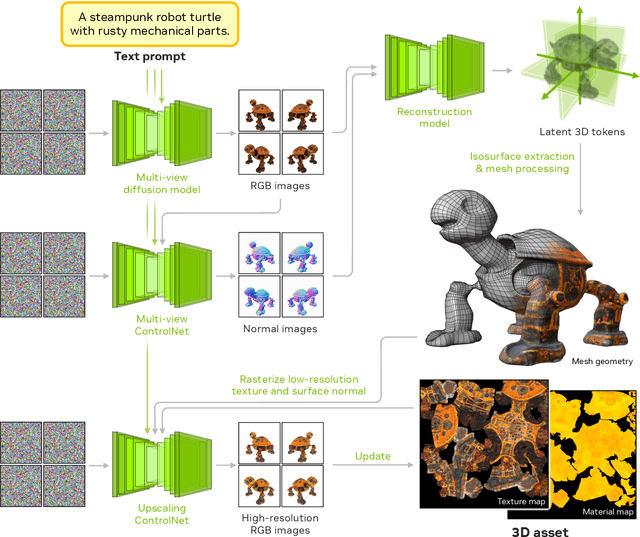
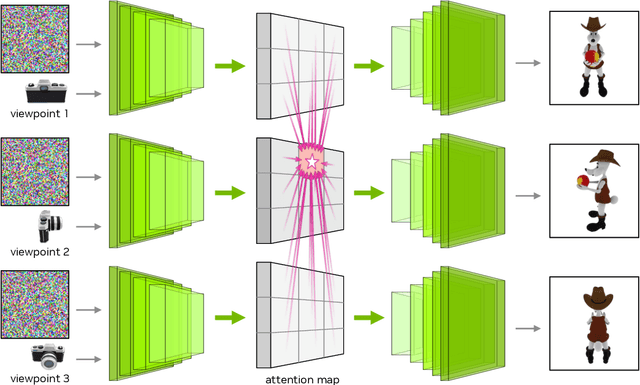
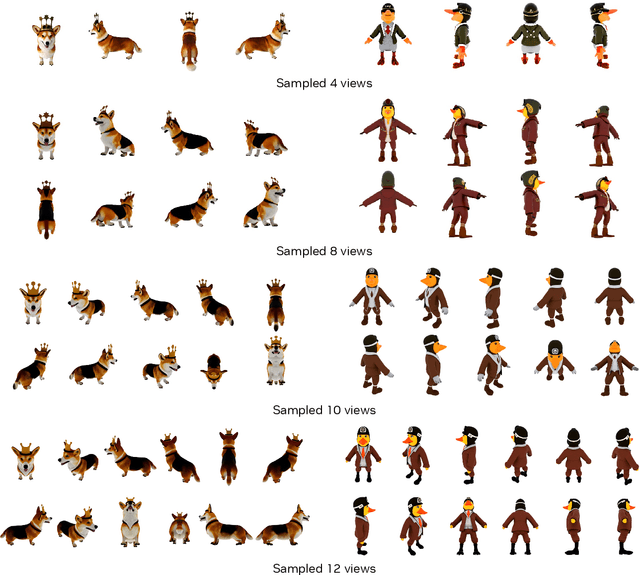
Abstract:We introduce Edify 3D, an advanced solution designed for high-quality 3D asset generation. Our method first synthesizes RGB and surface normal images of the described object at multiple viewpoints using a diffusion model. The multi-view observations are then used to reconstruct the shape, texture, and PBR materials of the object. Our method can generate high-quality 3D assets with detailed geometry, clean shape topologies, high-resolution textures, and materials within 2 minutes of runtime.
Why Fine-grained Labels in Pretraining Benefit Generalization?
Oct 30, 2024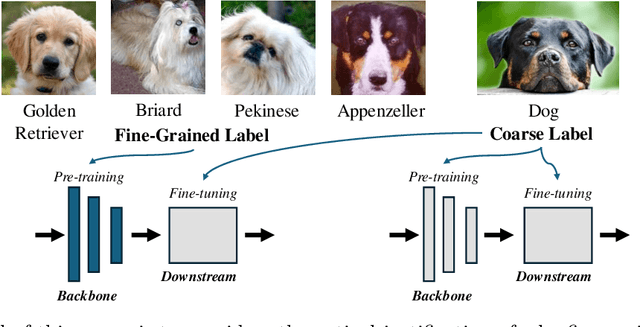

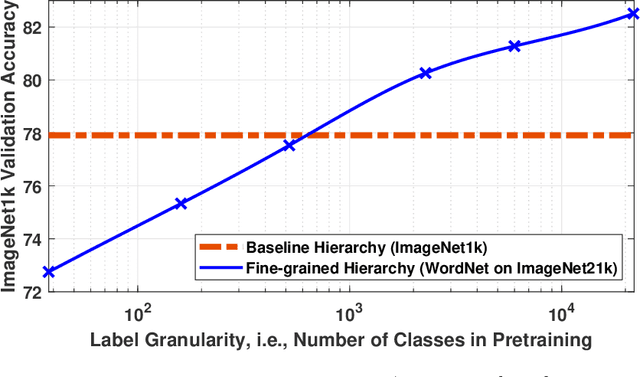

Abstract:Recent studies show that pretraining a deep neural network with fine-grained labeled data, followed by fine-tuning on coarse-labeled data for downstream tasks, often yields better generalization than pretraining with coarse-labeled data. While there is ample empirical evidence supporting this, the theoretical justification remains an open problem. This paper addresses this gap by introducing a "hierarchical multi-view" structure to confine the input data distribution. Under this framework, we prove that: 1) coarse-grained pretraining only allows a neural network to learn the common features well, while 2) fine-grained pretraining helps the network learn the rare features in addition to the common ones, leading to improved accuracy on hard downstream test samples.
Wolf: Captioning Everything with a World Summarization Framework
Jul 26, 2024



Abstract:We propose Wolf, a WOrLd summarization Framework for accurate video captioning. Wolf is an automated captioning framework that adopts a mixture-of-experts approach, leveraging complementary strengths of Vision Language Models (VLMs). By utilizing both image and video models, our framework captures different levels of information and summarizes them efficiently. Our approach can be applied to enhance video understanding, auto-labeling, and captioning. To evaluate caption quality, we introduce CapScore, an LLM-based metric to assess the similarity and quality of generated captions compared to the ground truth captions. We further build four human-annotated datasets in three domains: autonomous driving, general scenes, and robotics, to facilitate comprehensive comparisons. We show that Wolf achieves superior captioning performance compared to state-of-the-art approaches from the research community (VILA1.5, CogAgent) and commercial solutions (Gemini-Pro-1.5, GPT-4V). For instance, in comparison with GPT-4V, Wolf improves CapScore both quality-wise by 55.6% and similarity-wise by 77.4% on challenging driving videos. Finally, we establish a benchmark for video captioning and introduce a leaderboard, aiming to accelerate advancements in video understanding, captioning, and data alignment. Leaderboard: https://wolfv0.github.io/leaderboard.html.
Visual Fact Checker: Enabling High-Fidelity Detailed Caption Generation
Apr 30, 2024



Abstract:Existing automatic captioning methods for visual content face challenges such as lack of detail, content hallucination, and poor instruction following. In this work, we propose VisualFactChecker (VFC), a flexible training-free pipeline that generates high-fidelity and detailed captions for both 2D images and 3D objects. VFC consists of three steps: 1) proposal, where image-to-text captioning models propose multiple initial captions; 2) verification, where a large language model (LLM) utilizes tools such as object detection and VQA models to fact-check proposed captions; 3) captioning, where an LLM generates the final caption by summarizing caption proposals and the fact check verification results. In this step, VFC can flexibly generate captions in various styles following complex instructions. We conduct comprehensive captioning evaluations using four metrics: 1) CLIP-Score for image-text similarity; 2) CLIP-Image-Score for measuring the image-image similarity between the original and the reconstructed image generated by a text-to-image model using the caption. 3) human study on Amazon Mechanical Turk; 4) GPT-4V for fine-grained evaluation. Evaluation results show that VFC outperforms state-of-the-art open-sourced captioning methods for 2D images on the COCO dataset and 3D assets on the Objaverse dataset. Our study demonstrates that by combining open-source models into a pipeline, we can attain captioning capability comparable to proprietary models such as GPT-4V, despite being over 10x smaller in model size.
Module-wise Adaptive Distillation for Multimodality Foundation Models
Oct 06, 2023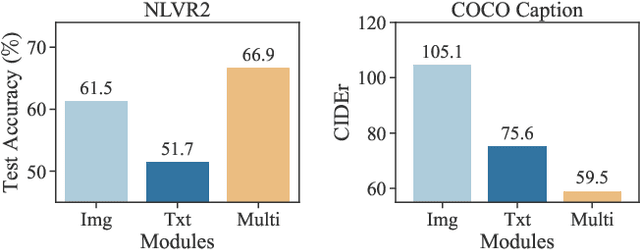
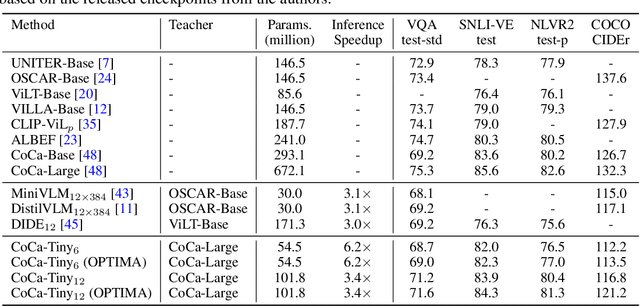
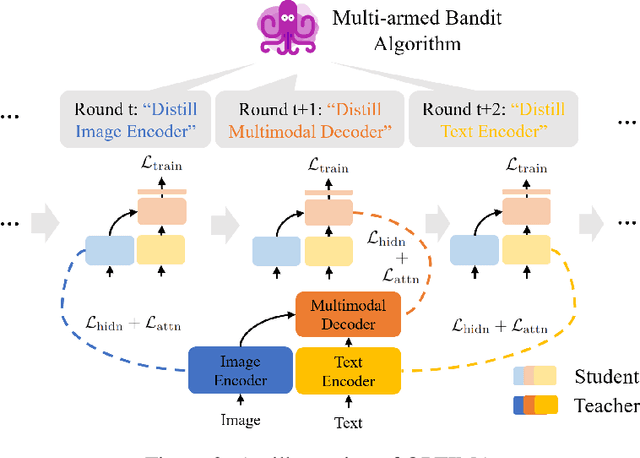
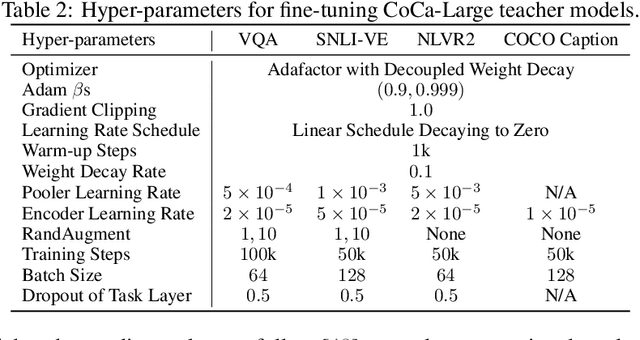
Abstract:Pre-trained multimodal foundation models have demonstrated remarkable generalizability but pose challenges for deployment due to their large sizes. One effective approach to reducing their sizes is layerwise distillation, wherein small student models are trained to match the hidden representations of large teacher models at each layer. Motivated by our observation that certain architecture components, referred to as modules, contribute more significantly to the student's performance than others, we propose to track the contributions of individual modules by recording the loss decrement after distillation each module and choose the module with a greater contribution to distill more frequently. Such an approach can be naturally formulated as a multi-armed bandit (MAB) problem, where modules and loss decrements are considered as arms and rewards, respectively. We then develop a modified-Thompson sampling algorithm named OPTIMA to address the nonstationarity of module contributions resulting from model updating. Specifically, we leverage the observed contributions in recent history to estimate the changing contribution of each module and select modules based on these estimations to maximize the cumulative contribution. We evaluate the effectiveness of OPTIMA through distillation experiments on various multimodal understanding and image captioning tasks, using the CoCa-Large model (Yu et al., 2022) as the teacher model.
 Add to Chrome
Add to Chrome Add to Firefox
Add to Firefox Add to Edge
Add to Edge